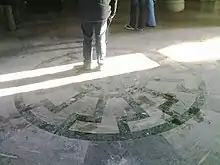Black Sun (symbol)
The Black Sun (German: Schwarze Sonne) is a Nazi symbol, a type of sun wheel (German: Sonnenrad)[1][2] employed in a post–Nazi Germany context by neo-Nazis and in some strains of Satanism.

The symbol's design consists of twelve radial sig runes, similar to the symbols employed by the SS in their logo. It first appeared in Nazi Germany as a design element in a castle at Wewelsburg remodeled and expanded by Heinrich Himmler which he intended to be a center for the SS. Whether the design had a name or held any particular significance among the SS remains unknown.
Its association with the occult originates with a 1991 German novel Die Schwarze Sonne von Tashi Lhunpo ("The Black Sun of Tashi Lhunpo") by the pseudonymous author Russell McCloud. The book links the Wewelsburg mosaic with the neo-Nazi concept of the "Black Sun", invented by former SS officer Wilhelm Landig as a substitute for the Nazi swastika.[3][4]
Wewelsburg mosaic

In 1933, Heinrich Himmler acquired Wewelsburg, a castle near Paderborn, Germany. Himmler intended to make the structure into a center for the SS, and between 1936 and 1942, Himmler ordered the building expanded and rebuilt for ceremonial purposes.[5]
As a product of Himmler's remodeling, twelve dark-green radially overlaid sig runes, such as those employed in the logo of the SS, appear on the white marble floor of the structure's north tower, the Obergruppenführersaal or 'General's Hall'. The intended significance of the image remains unknown, but the artist may have found inspiration from decorative Merovingian disks (Zierscheibe). According to the historian Nicholas Goodrick-Clarke:
[I]t has been suggested that this twelve-spoke sun wheel derives from decorative disks from the Merovingians of the early medieval period and are supposed to represent the visible sun or its passage through the months of the year. These disks were discussed in scholarly publications during the Third Reich and may well have served the Wewelsburg designers as a model.[3]
Neo-Nazism
The Black Sun symbol is widely used by neo-fascist, neo-Nazi,[6] the far-right and white nationalists. The symbol often appears on extremist flags, t-shirts, posters, websites and in extremist publications associated with such groups. Modern far-right groups often refer to the symbol as the sun wheel or Sonnenrad.[5][7][8]
The name "Black Sun" came into wider use after the publication of a 1991 occult thriller novel Die Schwarze Sonne von Tashi Lhunpo ('The Black Sun of Tashi Lhunpo') by the pseudonymous author Russell McCloud. The book links the Wewelsburg mosaic with the neo-Nazi concept of the "Black Sun", invented by former SS officer Wilhelm Landig as a substitute for the Nazi swastika and a symbol for a mystic energy source that was supposed to renew the Aryan race.[3][9][10]
A number of far-right groups and individuals have utilised the symbol in their propaganda, including the Christchurch mosque shooter, Australian neo-Nazi group Antipodean Resistance, and Ukrainian far-right National Guard regiment Azov Battalion.[11] The symbol was displayed by members of several extremist groups involved in the Unite the Right rally in Charlottesville, Virginia.[12]
Satanism
Along with other symbols from the Nazi era such as the Wolfsangel, the Sig rune, and the Totenkopf, the black sun is employed by some adherents of Satanism.[13] The scholar Chris Mathews writes:
Of the numerous permutations of the Wolfsangle [sic], Satanists adopt the form used by the SS and numerous fascist organizations. Likewise, the Totenkopf used in the nineteenth century by the Prussian military was markedly more cartoonish than the SS's Death Head version, which is the version Church of Satan members use. The Black Sun motif is even less ambiguous. Though based on medieval German symbols, the Wewelsburg mosaic is a unique design commissioned specifically for Himmler, and its primary contemporary association is Nazi occultism, for which Nazi Satanic groups and esoteric neo-Nazis adopt it.[13]
See also
References
- Grumke, Thomas; Wagner, Bernd (2002). Handbuch Rechtsradikalismus: Personen – Organisationen – Netzwerke vom Neonazismus bis in die Mitte der Gesellschaft (in German). Opladen: Leske + Budrich. p. 207. ISBN 978-3-81-003399-4.
- Goodrick-Clarke, Nicholas (2002). Black Sun: Aryan Cults, Esoteric Nazism, and the Politics of Identity. New York University Press. p. 125. ISBN 0-81-473124-4.
- Goodrick-Clarke (2002), p. 148.
- Strube, Julian (2015). "Nazism and the Occult". In Partridge, Christopher (ed.). The Occult World. Abingdon, UK: Routledge. p. 339. ISBN 978-0-41-569596-1.
- Goodrick-Clarke (2002), pp. 148–150.
- Luhn, Alec (30 August 2014). "Preparing for War With Ukraine's Fascist Defenders of Freedom". Foreign Policy.
- Grumke & Wagner (2002), p. 219.
- Neo Nazi groups:
- "Sonnenrad". Anti-Defamation League. Retrieved 26 July 2019.
- "Deconstructing the symbols and slogans spotted in Charlottesville". The Washington Post. 18 August 2017.
- Strube, Julian (2015). "Nazism and the Occult". In Partridge, Christopher (ed.). The Occult World. Abingdon, UK: Routledge. p. 339. ISBN 978-0-41-569596-1.
- Goodrick-Clarke (2002), p. 3.
- Neo-Nazi groups:
- Dearden, Lizzie (16 March 2019). "New Zealand attack: How nonsensical white genocide conspiracy theory cited by gunman is spreading poison around the world". The Independent. Archived from the original on 16 March 2019.
- Nathan, Julie (20 April 2018). "Antipodean Resistance: The Rise and Goals of Australia's New Nazis". ABC Religion & Ethics. Australian Beroadcasting Corporation.
- Colborne, Michael (10 April 2019). "The Christchurch shooting, Eastern Europe's far-right and a 'cherry-picked reading of history'". Australian Broadcasting Corporation.
- Unite the Right rally:
- Porter, Tom (13 August 2017). "Who are the White Nationalist Groups that Demonstrated in Charlottesville?". Newsweek.
- "Flags and Other Symbols Used By Neo-Nazi Groups in Charlottesville". Hatewatch. Southern Poverty Law Center. 12 August 2017.
- Mathews, Chris (2009). Modern Satanism: Anatomy of a Radical Subculture. Westport, Conn.: Praeger. p. 153. ISBN 978-0-313-36639-0.
External links
 Media related to Black Sun (symbol) at Wikimedia Commons
Media related to Black Sun (symbol) at Wikimedia Commons
